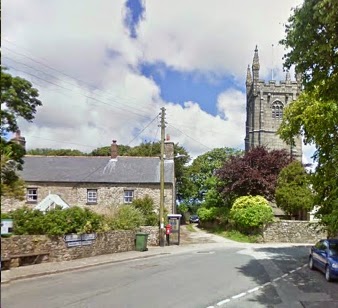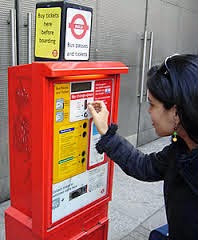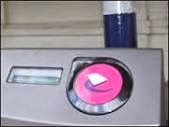For most people, a bus enthusiast is a bus spotter; a sad old man (the youngsters aren't interested these days) standing on a street corner with a notebook and a camera slavering excitedly about self-locking wheelnuts and the latest bifurcated wangle thrubbler in the new Euro 4.7 engines.
In many ways, fbb is not really interested in listening to (or even recording) the sound of a Volvo Dominator as it pulls up Thradworthy Hill.
So when fbb reveals his passion for public transport, those in the conversation change the subject rapidly or look round to see if the old man's carer has returned to take him back to the unit. Despite these appalling busist acts of stereotyping, fbb actually enjoys riding on buses because of where they go.
This it was on Thursday last that 10 journeys were undertaken in a nine hour period between 1030 and 1930, centred on Penzance. No attempt was being made to break any record; plenty of time was allowed for respite care (refreshment breaks and for other purposes!); it was pure infromative enjoyment.
It started here at the bottom of Alexandra Road, Penzance ...
... known as Western Promenade by First; also sometimes referred to as Wherrytown. The area was badly damaged by storms in 1962 ...
... and further pounded in February this year. This YouTube video is a reminder.
All was calm and peaceful as fbb took his first short trip via the town centre and to Penzance bus station.
There are four different routes to St Ives and fbb chose the unconventional way via little villages.
His steed was, yet again, one of those Optare thingeys, small enough to tackle Penwith's narrow lanes, many of which chubbo had encountered on his excursion (brief, thankfully) to Lands End the previous evening. See "Next Stop America : A Look at Land's End" (read again)
Ray Stenning's stylised map of the area does not do justice to the wiggliness of the route.
Our first (but fruitless, passenger-wise) port of call is Sainbury's, half way to Long Rock. We now turn back towards Penzance before a right hander which takes us under the by pass viaduct ...
... and into rural Penwith. Ludgvan is quaint ...
... although fbb would prefer to use "Church" as the time point rather that First's (near transparent) "telephone box". Next is Nancledra, but here the "telephone box" time point is more obvious and close to a timetable frame on a street lamp/telephone pole.
North of Nacledra we pass through Cripplesease and just before the "Built-up area" of the hamlet is this house.
"The Wink" was, of course, a pub; an explanation of the strange name is given in the Land's End blog with the "read again" link above.
On we go, collecting zero passengers, to Halsetown Inn ...
... which is barely Halsetown. Fortunately out of sight of the bus route is the massive Polmanter Park, aka Caravan site ...
... which, its blurb maintains, is within walking distance of St Ives.
Yes, that is St Ives in the far top left of the picture; a lovely walk with screaming children, picnic lunch, windbreak, beach cricket, parasol, towels and other essentials.
We have ridden narrow single track roads, we have experienced delightful little villages and now we approach St Ives via the suburb of Penbeagle. Here this bus stop (fuzzily extracted from Streetview) ...
... advertises itself as a stop for Western Greyhound route 508. It isn't and it doesn't. The company pulled out of Western Cornwall in May 2013. A brief breather at the Malakoff bus terminal (of which more in due course) with views over the beach ...
... before we set off back to Penzance.
Now most bus route designers would use the suffix "A" for a minor diversion from the main drag. Not so First Bus. The 16A is a completely different route with two little bits at each end in common with the 16. We set off via Penbeagle again aiming for the B3306 coast road to Zennor. But as Chris Tarrant would say on "Miillionaire", we don't want to give you that!
We go back via Halsetown Inn (PH, right) and via Towednack. Why? Possibly to maintain a service approximately every hour to Halsetown Inn. Towednack village consists of a delightful church ...
... and its associated huge vicarage (click on the picture for an enlargement) and numerous remote farmsteads. The church is still in use.
In December 1931 a hoard of gold ornaments was found near Towednack. Here, concealed in an ancient stone wall, was found a collection of beautiful gold objects, including two twisted neckrings, four armrings and two lengths of unfinished gold rod.
The gold is very fine, and probably came from Ireland. These ornaments date from the late Bronze Age and they now reside in the British Museum. A replica of the hoard can be seen at the Penlee Museum in Penzance.
And on to Zennor, named after its church's patronal Saint Senara. Passengers might be forgiven for missing this quaint little village as there is little to see from the bus stops on the main road ...
... except the church tower peeping above the hedgerows.The village has a pub and a small museum and a fishy claim to fame.
The legend of the mermaid of Zennor concerns a mermaid that visited St Senara's Church and enticed local vhorister Mathey Trewella away; both never to be seen again. The legend is probably enhanced by a 15th-century carved bench-end in the church that shows a mermaid. As with all such tales, there are many variations, possibly embellished after a visit to the said pub!
Our last call along this spectacular bit of coast with its impressive views of cliff and sea, is called "Gornards Head" in the First Bus timetable. This is Gurnards Head ...
... accessibly only by footpath and a hefty trek from the bus route. What First means to say is that the 16A calls at the Gurnards Head Hotel ...
... recently repainted in a lurid shade of marigold yellow. Whilst this is distinctive and ensures a bus passenger won't miss the stop ...
... it is perhaps a little too "yellow" for the Penwith purists!
The return to Penzance is over open moorland, glorious in sunshine, but wild and threatening in typical west country storms. One can almost imagine Ross Poldark riding at speed across the heather on his way back to enjoy the voluptuous arms of the delicious Demelza.
The marriage ceremonies in the 1979 TV series were filmed at Towednack Church.
Of course, all this richness of experience can be enjoyed by motor car, but probably not by the driver; and please ensure that your reversing skills are well honed! On the bus you see more and can leave the driving to the skilled man at the front - and, boy, does he (or she!) need those manoeuvering skills. Here are two 16As in a close encounter near Gurnards Head. As one passenger was heard to mutter, "Ach mein Gott!" fbb does not think she was English.
fbb cannot recommend a round trip by 16 and 16A too highly. It was the best ride of the day.
And it did. This from the Northampton evening paper on Saturday 28th
This it was on Thursday last that 10 journeys were undertaken in a nine hour period between 1030 and 1930, centred on Penzance. No attempt was being made to break any record; plenty of time was allowed for respite care (refreshment breaks and for other purposes!); it was pure infromative enjoyment.
It started here at the bottom of Alexandra Road, Penzance ...
... known as Western Promenade by First; also sometimes referred to as Wherrytown. The area was badly damaged by storms in 1962 ...
... and further pounded in February this year. This YouTube video is a reminder.
There are four different routes to St Ives and fbb chose the unconventional way via little villages.
His steed was, yet again, one of those Optare thingeys, small enough to tackle Penwith's narrow lanes, many of which chubbo had encountered on his excursion (brief, thankfully) to Lands End the previous evening. See "Next Stop America : A Look at Land's End" (read again)
Ray Stenning's stylised map of the area does not do justice to the wiggliness of the route.
Our first (but fruitless, passenger-wise) port of call is Sainbury's, half way to Long Rock. We now turn back towards Penzance before a right hander which takes us under the by pass viaduct ...
... and into rural Penwith. Ludgvan is quaint ...
... although fbb would prefer to use "Church" as the time point rather that First's (near transparent) "telephone box". Next is Nancledra, but here the "telephone box" time point is more obvious and close to a timetable frame on a street lamp/telephone pole.
North of Nacledra we pass through Cripplesease and just before the "Built-up area" of the hamlet is this house.
"The Wink" was, of course, a pub; an explanation of the strange name is given in the Land's End blog with the "read again" link above.
On we go, collecting zero passengers, to Halsetown Inn ...
... which is barely Halsetown. Fortunately out of sight of the bus route is the massive Polmanter Park, aka Caravan site ...
... which, its blurb maintains, is within walking distance of St Ives.
Yes, that is St Ives in the far top left of the picture; a lovely walk with screaming children, picnic lunch, windbreak, beach cricket, parasol, towels and other essentials.
We have ridden narrow single track roads, we have experienced delightful little villages and now we approach St Ives via the suburb of Penbeagle. Here this bus stop (fuzzily extracted from Streetview) ...
... advertises itself as a stop for Western Greyhound route 508. It isn't and it doesn't. The company pulled out of Western Cornwall in May 2013. A brief breather at the Malakoff bus terminal (of which more in due course) with views over the beach ...
... before we set off back to Penzance.
Now most bus route designers would use the suffix "A" for a minor diversion from the main drag. Not so First Bus. The 16A is a completely different route with two little bits at each end in common with the 16. We set off via Penbeagle again aiming for the B3306 coast road to Zennor. But as Chris Tarrant would say on "Miillionaire", we don't want to give you that!
We go back via Halsetown Inn (PH, right) and via Towednack. Why? Possibly to maintain a service approximately every hour to Halsetown Inn. Towednack village consists of a delightful church ...
... and its associated huge vicarage (click on the picture for an enlargement) and numerous remote farmsteads. The church is still in use.
In December 1931 a hoard of gold ornaments was found near Towednack. Here, concealed in an ancient stone wall, was found a collection of beautiful gold objects, including two twisted neckrings, four armrings and two lengths of unfinished gold rod.
The gold is very fine, and probably came from Ireland. These ornaments date from the late Bronze Age and they now reside in the British Museum. A replica of the hoard can be seen at the Penlee Museum in Penzance.
And on to Zennor, named after its church's patronal Saint Senara. Passengers might be forgiven for missing this quaint little village as there is little to see from the bus stops on the main road ...
... except the church tower peeping above the hedgerows.The village has a pub and a small museum and a fishy claim to fame.
The legend of the mermaid of Zennor concerns a mermaid that visited St Senara's Church and enticed local vhorister Mathey Trewella away; both never to be seen again. The legend is probably enhanced by a 15th-century carved bench-end in the church that shows a mermaid. As with all such tales, there are many variations, possibly embellished after a visit to the said pub!
Our last call along this spectacular bit of coast with its impressive views of cliff and sea, is called "Gornards Head" in the First Bus timetable. This is Gurnards Head ...
... accessibly only by footpath and a hefty trek from the bus route. What First means to say is that the 16A calls at the Gurnards Head Hotel ...
... recently repainted in a lurid shade of marigold yellow. Whilst this is distinctive and ensures a bus passenger won't miss the stop ...
... it is perhaps a little too "yellow" for the Penwith purists!
The return to Penzance is over open moorland, glorious in sunshine, but wild and threatening in typical west country storms. One can almost imagine Ross Poldark riding at speed across the heather on his way back to enjoy the voluptuous arms of the delicious Demelza.
The marriage ceremonies in the 1979 TV series were filmed at Towednack Church.
Of course, all this richness of experience can be enjoyed by motor car, but probably not by the driver; and please ensure that your reversing skills are well honed! On the bus you see more and can leave the driving to the skilled man at the front - and, boy, does he (or she!) need those manoeuvering skills. Here are two 16As in a close encounter near Gurnards Head. As one passenger was heard to mutter, "Ach mein Gott!" fbb does not think she was English.
fbb cannot recommend a round trip by 16 and 16A too highly. It was the best ride of the day.
--------------------------------------------------
Told You So!
Having blogged about the shambles that accompanied the opening of Northampton's new bus station, a shambles that appeared to be resolved after a few days, both fbb and his Northampton correspondent opined that any slight problem would recreate utter chaos.
Bus congestion:‘faulty traffic lights’
bring town centre to a standstill.
A faulty traffic light was blamed for bringing Northampton town centre to a standstill on Saturday, leaving people trapped in the Grosvenor Centre car park. The lights were changing at unusually quick sequences next to the new North Gate Bus Station and caused buses entering and leaving to queue, leading to congestion in surrounding streets, according to bus station workers.Traffic was backed up all the way into the Grosvenor Centre car park, all the way down Bridge Street and down Gold Street between 2pm and 3pm.
Homeward bound from shopping centre car park!
--------------------------------------------------
Next bus blog : Tuesday 1st July


















































